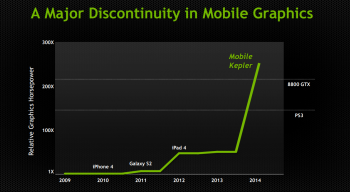
NVIDIA announces Mobile Kepler GPU; exceeds PS3’s power, comes to mobile in Project Logan [VIDEO]
NVIDIA was at SIGGRAPH this week to announce some exciting new developments for its mobile computing platform. The company has revealed new details about the GPU that’ll be going inside its latest Logan chipset (which is set to be here in 2014). The GPU is based on Kepler technology, the same architecture being used in cards such as NVIDIA’s GeForce GTX Titan card for desktop PCs. What does that bring us on the mobile side of things?
Kepler supports the full spectrum of OpenGL – including the just-announced OpenGL 4.4 full-featured graphics specification and the OpenGL ES 3.0 embedded standard. It also supports DirectX 11, Microsoft’s latest graphics API.
Alright, so what exactly does that mean? Well, it means being able to achieve a very high level of graphics. In fact, it’s so high that NVIDIA confidently advertises it delivers even more power than Sony’s PlayStation 3 (yes, that’s the same console which delivered highly-detailed titles such as Killzone, Uncharted and The Last of Us.
Asked if that sort of performance was only theoretical, NVIDIA said no — that sort of stuff can be achieved in a real mobile computing environment as long as the developers have the technical know-how.
To give us a look at just how nice this Kepler-based mobile GPU will be, NVIDIA put together a handy video of a demo that was run on an NVIDIA reference table with the Logan chipset inside. It’s the FaceWorks “Ira” demo you see above, which shows a life-like human face making many different emotions. The demo shows off things like advanced tessellation, realistic light modeling, and more.
NVIDIA revealed that there were a few trade-offs that had to be made in order to get Ira to run this beautifully and smoothly, but the very minuscule degradation in graphics allowed them to get the type of performance they needed to be able to run such a beautiful demo at full HD resolution.
And it’s all doing this while sipping on power. Whereas desktop Kepler systems rely on 250-watt power draws, Mobile Kepler only needs about 2-3 watts. That efficiency alongside other power-saving tweaks make it possible to run these graphics using the limited supply of power that mobile devices tend to have.
NVIDIA didn’t want to reveal absolutely everything there is to know about this beast just yet, but just know it’ll be on its way starting at some point in 2014 (and if you don’t believe me, NVIDIA revealed that Project Logan silicon is already being sampled by major OEMs today).
Sure, it’s a bit odd to be talking about Project Logan when we haven’t even started seeing the first readily available Tegra 4 devices yet, but we’re excited regardless. Be sure to watch the two video demos above, and let us know if you’re just about ready to throw your money at the first Logan device that comes our way late next year.
[via NVIDIA]